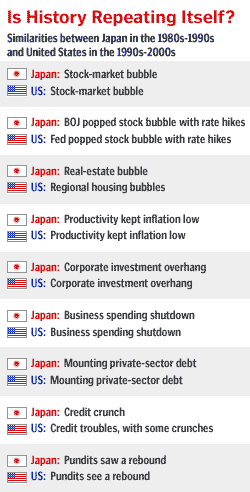NEW YORK (CNN/Money) -
When the Labor Department said Friday that wholesale prices fell in November, some nervous hand-wringing by business leaders and economists resulted, as they worried a deflationary beast was gathering strength to menace the U.S. economy.
Some economists think the drop in the producer price index (PPI) owed as much to automakers' addiction to zero-percent financing as anything else. Nevertheless, it was a reminder that businesses are having a tough time raising prices -- and this could be bad news for the economy.

"The prospect of deflation is one that sends shudders through financial markets," said Jerry Jasinowski, president of the National Association of Manufacturers, who called for President Bush and Congress to throw businesses a lifeline in the form of fiscal stimulus.
While at first blush it might sound like a good thing that prices are falling -- after all, who in their right mind would want to pay more for the stuff they buy? -- the economic consequences could be devastating if deflation, an unstoppable drop in prices, keeps businesses from turning a profit.
Just ask Japan; the world's second-largest economy has been in a deflationary spiral for years. Companies can't raise prices for the goods they make or services they provide; in order to stay afloat, they have to keep costs low, and one of the easiest ways to do that is to keep their labor force lean.
U.S. businesses have already cut 1.8 million jobs from their payrolls in 2001 and 2002. If they're discouraged from adding to payrolls -- or if they're forced to cut even more jobs -- then consumer spending, which makes up more than two-thirds of the total economy, could suffer.
Lower consumer spending, of course, would mean lower revenue for businesses, which would raise the need for more cost-cutting, and the whole miserable cycle would begin anew.
Most economists don't think this cycle has started yet. If you've paid a doctor bill or signed a college tuition check lately, you've gotten a painful lesson in how inflation still has a grip on the service sector.
| Related stories
|

|
|
|
|
And the slowdown in inflation for some consumer goods could have something to do with robust productivity growth, which cuts the cost of producing goods, savings that can be passed on to the consumer.
Though the Federal Reserve admittedly had one eye on deflation when it slashed interest rates in November, Chairman Alan Greenspan has said he finds the likelihood of deflation remote, and many economists agree.
"While goods producers continue to have little to no pricing power, we still believe the odds of outright deflation remain fairly low," said Wachovia senior economist Mark Vitner.
Some sectors already in deflation
But there's no question that some sectors are already in deflation, or at least "disinflation," inflation that barely has a pulse.
One measure of inflation, the gross domestic product (GDP) price index, grew just 0.8 percent year-over-year in the third quarter of 2002 -- the lowest rate since the second quarter of 1950, according to Morgan Stanley chief economist Stephen Roach.
And the GDP price index for consumer durable goods dropped 2.6 percent between the third quarter of 2001 and the third quarter of 2002 -- meaning there's full-fledged deflation for goods meant to last three years or more, like cars and computers.
In fact, November's PPI was dragged down by those two sectors, according to the Labor Department report. Passenger car prices dropped 3.6 percent, while computer prices fell 2.0 percent.
But the drop in overall PPI followed a big gain in October, and deflation in producer prices might actually be old news by now.
"If you look at the 12-month change in producer prices, it's positive 0.9 percent," said Gary Thayer, chief economist at A.G. Edwards & Sons. "As recently as May, the 12-month change was negative 2.8 percent -- so there were a lot more deflationary pressures earlier in year, and those seem to be abating."
And super-low inflation hasn't always been a bad thing for business -- prices were dead in the water in the late 1950s and early 1960s, but companies still managed to turn a profit, and the U.S. economy posted some of its best growth in the post-war period.
While corporate profits haven't really started to rebound with any gusto, they could do so if there's a jump in demand for output while prices for input are low.
"Firms should be experiencing significant easing in cost pressures as the weak commodity prices are adding to the strong productivity gains, which are keeping labor costs down," said Joel Naroff, president and chief economist of Naroff Economic Advisors. "Now if demand would only pick up a bit, the earnings would go right to the bottom line."
Of course, that's a big "if."

|

